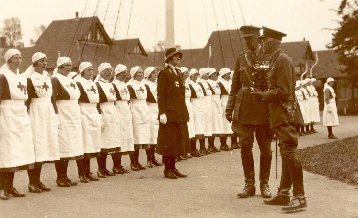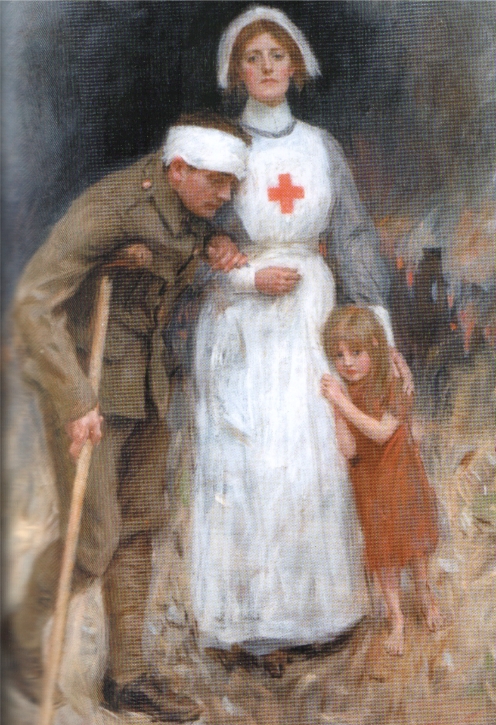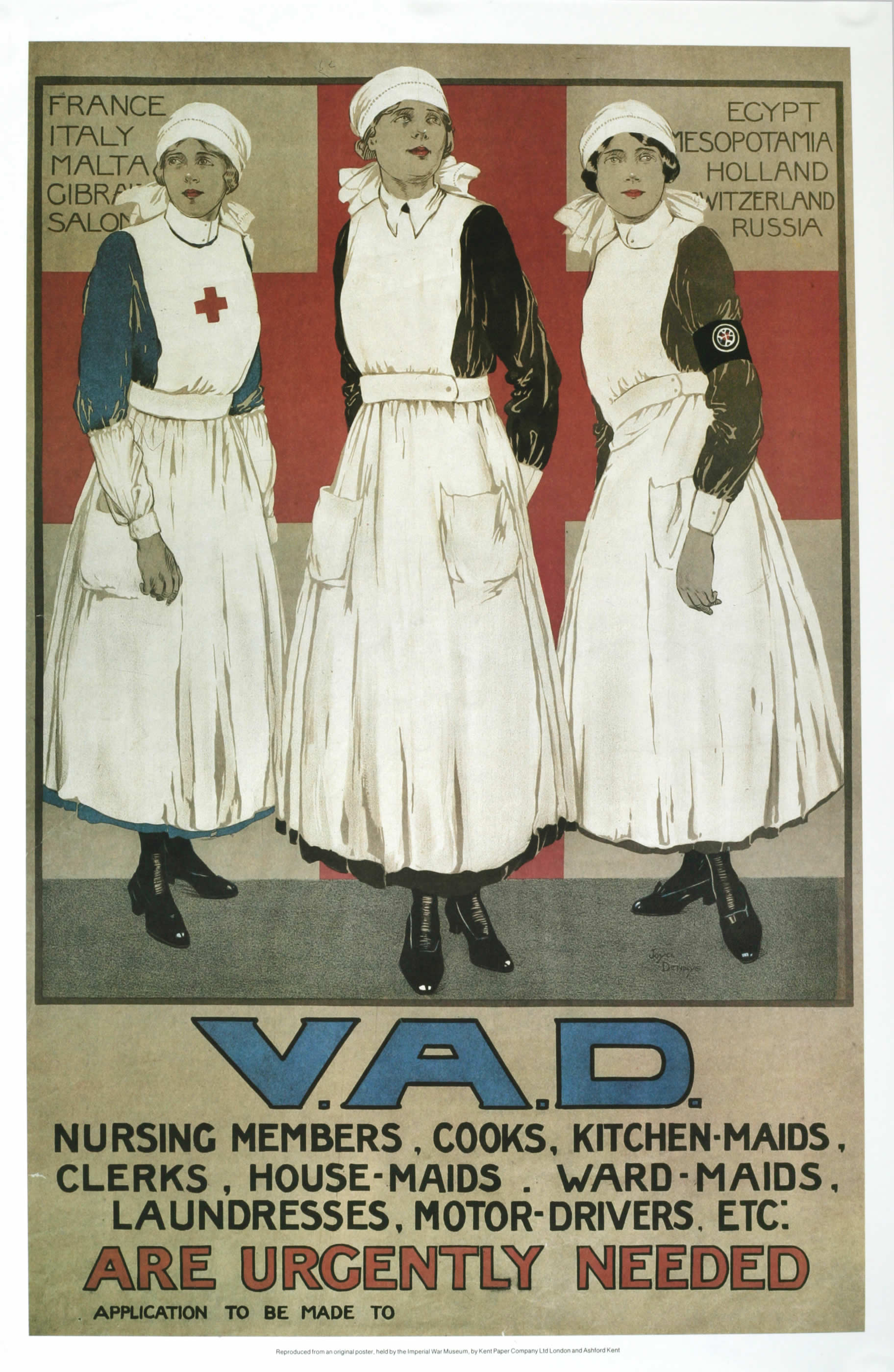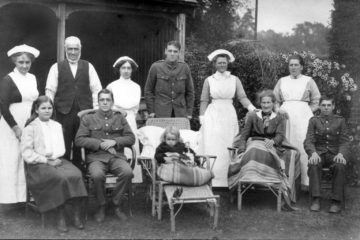For the middle and upper class women, who had very few career options, the temptation of actually working to help the country appealed greatly. Many of Britain’s women worked in munitions, as clerks, or were lured into nursing by posters such as “The Greatest Mother in the World” (fig. f).
This 1918 poster by Alonzo Earl Foringer for the British Red Cross tries to appeal to a woman’s ‘natural instinct’. Women are traditionally portrayed as nurturers with motherly instincts and here, the saintly Madonna figure seated is ‘the greatest mother in the world’. Robed and veiled with the Red Cross sign on her hat and gazing towards heaven, she cradles a wounded soldier in a stretcher. Sharon Ouditt states of this poster, “The icon is a bizarre intersection of the Madonna and child and the Pietà. It emphasises the ‘holiness’ of the war at the same time as it encourages women to adopt a Marion role.”[1] The overall message is simple; the war is necessary; god is watching over us; women are natural carers and therefore should take this role in the war effort.
In 1909, the Voluntary Aid Detachment (V.A.D) was established between the British Red Cross and the Order of St. John of Jerusalem, to provide medical assistance in the days prior to the National Health Service, which was introduced in 1948. By the summer of 1914, members totalled over 74,000 of which two-thirds were women. Recruitment posters for women to join the VAD soon appeared to try and enhance these numbers, tempting them with new roles and faraway places.
In this poster (fig. g), we see three strong and able-looking women in nurse’s uniforms, staring into the distance.
Behind them are names of countries suggesting their possible exotic destination. Despite looking like nurses, “The V.A.D members were not… trained nurses; nor were they entrusted with trained nurses’ work except on occasions when the emergency was so great that no other course was open.”[2] These women look very clean, calm and sanitary, when in truth their job would be stressful, dirty and dangerous and they would have had to endure terrible hardship. Posters such as these promote myths; the ideology of a job, a life, and a certain status that goes hand-in-hand with signing up. It is based upon the notion that “Ideology represents the imaginary relationship of individuals to their very real conditions of existence…”[3] that the VAD posters relied on to encourage successful recruitment of female volunteers.

Not only were the living conditions of a VAD very poor, but also the extent of what they witnessed was horrific. Vera Brittain, in her book Testament of Youth recalls, while stationed in Boulogne, “…the hut was reserved for gassed cases, and I had once again the task of attending to the blinded eyes and scorched throats and blistered bodies which made the struggle for life such a half-hearted affair.”[4] Yet the aim was to encourage women to volunteer as they were in desperate need for people.

These women did very important work and looked after thousands of Allied soldiers, if a realistic image of the job was portrayed then subscription would decline. In fig. h, we see a painting of a saintly mother figure in a nurse’s uniform caring for a small girl and a wounded soldier. This painting was a design for a possible recruitment poster, and may appeal to women as it not only shows the ideology of nursing, it also doesn’t depict the true image of war. With a bandaged head, and resting on a crutch, this soldier has managed to escape relatively unharmed compared to many others. For example, Mairi Chisholm was 18 when the war broke out, and volunteered as a VAD. She was sent to the front where she saw horrifying carnage:
There was this one boy very badly hit in the head and the brain was emerging. And we had a discussion with the Belgian doctor from the trenches with us, as to whether it was worth trying to do anything about this fellow. The brain was damaged to the extent that it would never be right, and there were masses of wounded coming in. We just opened up everything and let the brain drop into a bucket. That shows you what has to happen in certain circumstances. The ones that were saveable – must be saved.[5]
Mairi Chisholm
[1] Sharon Ouditt, Fighting Forces, Writing Women: Identity and Ideology in the First World War, Routledge, London, 1994, .p.20
[2] An Official Report by the Joint War Committee of the British Red Cross Society and Order of St. John, in Vera Brittain, Testament of Youth: An Autobiographical Study of the Years 1900-1925, Penguin Twentieth-Century Classics, 1933, p.410
[3] Louis Althusser, ‘Ideology and Ideological State Apparatuses’ in Lenin and Philosophy and Other Essays, New Left Books, 1971, quoted in Judith Williamson, Decoding Advertisements, p.40
[4] Vera Brittain, Testament of Youth, p.405
[5] Mairi Chisholm, IWM 000771/04 in ed. Nigel Fountain, Women At War, Michael O’Mara Books Ltd, London, 2002, p. 42-43




0 Comments